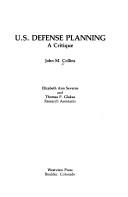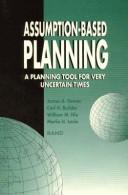| Listing 1 - 8 of 8 |
Sort by
|
Book
ISBN: 9780415565226 9780203842034 9781136902857 9781136902895 9781136902901 9781138881976 Year: 2011 Publisher: Milton Park, Abingdon, Oxon ;New York Routledge
Abstract | Keywords | Export | Availability | Bookmark
 Loading...
Loading...Choose an application
- Reference Manager
- EndNote
- RefWorks (Direct export to RefWorks)

ISBN: 0865315493 Year: 1982 Publisher: Boulder, CO : Westview,
Abstract | Keywords | Export | Availability | Bookmark
 Loading...
Loading...Choose an application
- Reference Manager
- EndNote
- RefWorks (Direct export to RefWorks)

ISBN: 0833013416 Year: 1993 Publisher: Santa Monica, CA : Rand Corporation,
Abstract | Keywords | Export | Availability | Bookmark
 Loading...
Loading...Choose an application
- Reference Manager
- EndNote
- RefWorks (Direct export to RefWorks)
Book
ISBN: 9780691137025 Year: 2009 Publisher: Princeton, NJ : Princeton University Press,
Abstract | Keywords | Export | Availability | Bookmark
 Loading...
Loading...Choose an application
- Reference Manager
- EndNote
- RefWorks (Direct export to RefWorks)
Book
Abstract | Keywords | Export | Availability | Bookmark
 Loading...
Loading...Choose an application
- Reference Manager
- EndNote
- RefWorks (Direct export to RefWorks)
MILITARY PLANNING--USA --- USA--MILITARY POLICY--FORECASTING
Book
ISBN: 9781626162457 Year: 2015
Abstract | Keywords | Export | Availability | Bookmark
 Loading...
Loading...Choose an application
- Reference Manager
- EndNote
- RefWorks (Direct export to RefWorks)
Are we winning ? Combatants often find themselves asking this question, especially during today's protracted asymmetrical conflicts where victory and defeat are not clear or easy to measure. Also, too often politics or wishful thinking take the place of objective assessment. This book explores how the trajectory of war has been analyzed in conflicts throughout American history. It brings together military historians, political scientists, and military officers to examine wartime assessment in theory, in practice through historical and contemporary cases, and through alternative dimensions of assessment such as justice and proportionality, the war of ideas, and economics. The cases start with the Seven Year's War and cover all major US conflicts through the war in Afghanistan. There are also unique examinations of how Al Qaeda has assessed its war on the United States and how assessment might be conducted in cyber war. Wartime assessment is critical because forming an accurate picture is essential to developing the right strategy. This book concludes with advice for practitioners about best approaches, though it also offers sobering conclusions about the difficulty of assessing war objectively and without politicization or self delusion.
Book
ISBN: 0895491079 Year: 1995 Publisher: Cambridge, MA : Institute for Foreign Policy Analysis,
Abstract | Keywords | Export | Availability | Bookmark
 Loading...
Loading...Choose an application
- Reference Manager
- EndNote
- RefWorks (Direct export to RefWorks)
Book
ISBN: 9780415605731 9781315818764 9781317817833 9781317817840 9781317817857 9781138206090 Year: 2016 Publisher: London Routledge, Taylor & Francis Group
Abstract | Keywords | Export | Availability | Bookmark
 Loading...
Loading...Choose an application
- Reference Manager
- EndNote
- RefWorks (Direct export to RefWorks)
How can countries decide what kind of military forces they need, if threats are uncertain and history is full of strategic surprises ? This is a question that is more pertinent than ever, as countries across the Asia-Pacific are faced with the military and economic rise of China. Uncertainty is inherent in defence planning, but different types of uncertainty mean that countries need to approach decisions about military force structure in different ways. This book examines four different basic frameworks for defence planning, and demonstrates how states can make decisions coherently about the structure and posture of their defence forces despite strategic uncertainty. It draws on case studies from the United States, Australia and New Zealand, each of which developed key concepts for their particular circumstances and risk perception in Asia. Success as well as failure in developing coherent defence planning frameworks holds lessons for the United States and other countries as they consider how best to structure their military forces for the uncertain challenges of the future'.
MILITARY PLANNING--ASIA --- MILITARY PLANNING--USA --- MILITARY PLANNING--AUSTRALIA --- MILITARY PLANNING--NEW ZEALANDMILITARY PLANNING--PACIFIC AREA --- CHINA--MILITARY POLICY --- USA--MILITARY POLICY --- AUSTRALIA--MILITARY POLICY --- NEW ZEALAND--MILITARY POLICY --- Polemology --- Far East
| Listing 1 - 8 of 8 |
Sort by
|

 Search
Search Feedback
Feedback About UniCat
About UniCat  Help
Help News
News